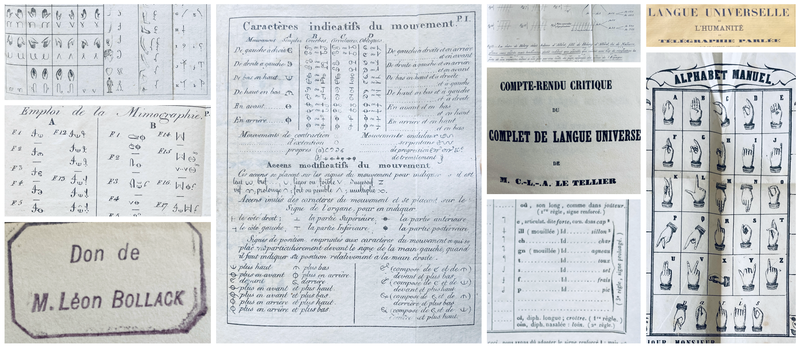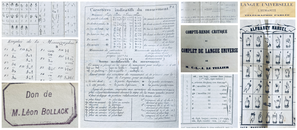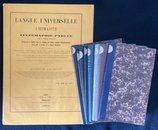Universal Language: collection of rare treatises from the library of Léon Bollack
PRICE LIST: Langue Universelle updated

In Search of the key to the Tower of Babel: who speaks the blue language?
FULLY ILLUSTRATED LIST: Langue Universelle updated
From the library of the creator of “La Langue Bleue.”
A collection of rare universal languages treatises from the library of Léon Bollack (1859-1925), a Parisian businessman and the inventor of “Bolak”, which was also known as "la Langue Bleue", a competing language with Esperanto. Bollack wrote and published several works related to the project: La Langue Bleue Bolak: langue internationale pratique (1899), Grammaire abrégée de la langue bleue (1900) and Premier vocabulaire de la langue bleue Bolak (1902). In 1907 Bollack gave up his project and shifted support to another language system, Ido, a reformed version of Esperanto. His wet stamp ex dono appears in eight of the nine titles here. Notably, the works bearing Bollack’s stamp (i.e., all but Caumont’s Langue Universelle) were published before he was born, indicating his dedication to the history of universal languages, which undoubtedly informed his own work when developing “Bolak.”
Speed and efficiency in the Industrial Revolution:
The 19th century saw the development of a number of life changing technological forces, such as the telegraph, the steam engine, and the railroad, that increased the speed and spread of communication. Similarly, an increase in the number of language systems like Bolak, Esperanto, and Ido, but also stenography, sign language for deaf-mutes, etc., sought to remove the barriers of native languages and thus increase the speed and efficiency of communication. The creation of universal languages was approached from a number of perspectives, documented by the nine titles offered here.
1). Roch Ambroise Auguste Bébian. Mimographie : ou Essai d'écriture mimique, propre a régulariser le langage des sourds-muets
Paris: Chez Louis Colas, Libraire, rue Dauphine, no. 32, 1825.
(21.5 x 13.3 cm). vi, 42 pages, 3 folded of plates. Cloth spine over marbled paper boards, gilt title on spine. Some spotting, but otherwise excellent copy. Bollack ex dono.
SOLD
2). Augustin Grosselin. Système de langue universelle, par A. Grosselin. Discours prononcé par M. Grosselin, à la séance d’ouverture de son cours de langue universelle, le Dimanche 27 novembre 1836.
Paris: Roret, n.d. [1836]
(21.5 x 13.3 cm).24 pp. Cloth spine over marbled paper boards, gilt title on spine, publisher’s original wrappers bound in. Some spotting. Bollack ex dono.
SOLD
3). [Charles Louis] Marle. Manuel de la diagraphie : découverte qui simplifie l'étude de la langue / par M. Marle aîné,...
Paris, Librairie Normale d’Éducation de Paul Dupont, 1839
(22 x 14.5 cm). 72 pp. Original publisher’s printed paper cover over thin boards, soiling to covers, but a solid and very good copy. Bollack ex dono.
2 copies in OCLC.
$1,400
Charles-Louis Marle (1799-1860) was a French grammarian who gained some fame for his attempt at spelling reform, which is presented in this work, in which he describes a purely phonetic script that he called “diagraphie”: a 19-symbol alphabet that is employed to represent all the sounds of spoken language. This system was explained by him in two works: Manuel de diagraphie (the present title) and Grammaire théorique, pratique et didactique, ou texte primitive de la grammaire diagraphique (Paris, Dupont, 1839).
••••
“People are solicited by the same interests; railways bring them closer together; a common language must reconcile and unite them. The fate of mankind depends on the co-operation of three great civilizing powers: the universal language, the telegraph, and the steam engine, symbols of intelligence, activity, and strength.”[1] –from the author’s preface.
4). Esquisse d'une langue universelle.
Paris : Bertrand, 1843
(22 x 14 cm). [6], xiv, 201, [3] pp. Cloth spine over marbled paper boards, gilt title on spine. Two folding plates of diagrams. Annotations, underlining, and scattered notes from a previous reader clearly studying the text . Bollack ex dono.
$2,500
An earlier edition appeared under the imprint Librairie orientale de Ve. Dondey-Dupré, Paris, 1837, which appears to be the same sheets with different title page, but without the post-scriptum, which in our copy is also annotated by a former reader, as is the main part of the text. Contains a writing system that the author offers as a replacement for stenographic methods. OCLC lists only a single copy of this edition, and only four of the 1837. The folding plates diagram the author’s system, which are complemented by seven explanatory tables.
The copy bears a number of annotations in pencil, especially in the postscript.
5). Frégier, Jh.-Casimir. De la langue universelle et analytique d'É.-T.-T. Vidal / par Jh.-Casimir Frégier.
Impr. de Martin, Aix, 1846
(22.5 x 14.5 cm). [2], 20 pp. Cloth spine over marbled paper boards, gilt title on spine. Bollack ex dono.
É.T.T. Vidal was a stenographer and author of several texts related to the art of “writing as quickly as one can speak”, particularly across languages. In this brief explanatory work, Jh.-Casimir Frégier gives a summary of the benefits of a universal language and more particularly Vidal’s system and its virtues, plus a short explanation of its principle mode of operation—it reads like an erudite promotional précis.
$800
Vidal’s Langue universelle et analytique first appeared in Paris, 1844. He was also the author of Sténographie vertical (1849). Vidal argued that, to write and translate a language before learning to speak it, it is enough to have the translation of the given work in one’s own language.
OCLC: 3 copies in France only.
6). Jean Pierre Rambosson. Langue universelle: langage mimique, mimé et écrit, développement philosophique et pratique.
Paris, France : Garnier, Libraires au Palais-Royal, 1853.
(22 x 13.5 cm). [4], 43, [1] pp. Folding plate illustrating sign language, which is absent in some copies. Cloth spine over marbled paper boards, gilt title on spine, original wrappers bound in. Spotting. Bollack ex dono.
SOLD
7). Léon Tillard. Compte rendu critique du "Cours complet de langue universelle" de M.C.-L.-A. Le Tellier, par L. Tillard.
Caen : Impr. de Vve Pagny, 1855
(22 x 13.5 cm). 14 pp, an 1pp. table of contents. Cloth spine over marbled paper boards, gilt title on spine. Excerpt from the journal "Le Moniteur du Calvados." Bollack ex dono.
OCLC: BnF only.
$400
In this pamphlet Léon Tillard reviews Cours complet de langue universelle by Charles-Constant Le Tellier (1768-1846), the French lexigrapher, author of Dictionnaire (nouveau) portatif de la langue française, ou Vocabulaire rédigé d’après le Dictionnaire de l’Académie et les ouvrages des meilleurs grammairiens (1827). Le Tellier’s Cours complet de langue universelle is a two-volume work that falls into a category of artificial languages that “used more conventional means, that is, letters, syllables, and words, to constitute the vocabulary of an artificial language. In several of these languages, letters and their position in syllables and words were used to reflect a classification scheme, so that the structure of a word indicated the position which the thing designated by that word occupied within the classification.” (cf. Maat & Cram, pp. 249-50)
8). Casimir Henricy. Société de linguistique. Extrait du rapport du Comité de la langue universelle, par M. Casimir Henricy ... lu dans la séance du 3 juillet 1856.
Paris: Bureaux du Cosmos, 1856.
(24 x 15 cm). 8 pp. Cloth spine over marbled paper boards, gilt title on spine. Bollack ex dono.
OCLC: BnF only.
$450
Henricy provides his secretary’s report for the July 3, 1856 meeting of the Committee to form a universal language of the Société de linguistique. The function of the latter, as stated by Henricy, was to “deal with all subjects related to philology and linguistics considered in their greatest extension, and especially from a practical point of view… [also], while carrying out a more or less radical reform of the spelling of the French language, [address the] question of… the idea of a universal language.” The report then provides “a summary and quick presentation of the work of the Universal Language Committee… showing you the path that this Committee has followed, the obstacles that have stood under in its path, [and] the magnitude and difficulties of the task it has accepted.”
Casimir Henricy (1814-1900), was a linguist, journalist, and French politician who in the 1850-60s collaborated on efforts to create a universal language; it has been noted by Décimo that “his intellectual biography mirrors the ideological atmosphere of a large swath of the republican and bourgeois population at that time, affinity for social and religious utopias, both fascinated by positivism and anchored in traditional patterns of patriotic thought” (cf. Décimo, Marc. (2012). “A propos de l'aventure de La Tribune des linguistes (1854-1860): utopie et dépassement”).
9). Aldrick Caumont. Langue universelle de l'humanité, ou, Télégraphie parlée par le nombre agissant: réduisant à l'unité tous les idiomes du globe compris instantanément d'un pôle à l'autre et à toutes distances.
Paris : A. Durand ; Bruxelles : Bruylant-Christophe, 1867
(36 x 27 cm). iii, 23 pages; Bright original publisher’s yellow wrappers printed in black.
$800
This work aims to create a universal language that through a concordance of phrases in eight languages (French, English, German, Italian, Spanish, Latin, Greek, and Hebrew) will allow members of different native language groups to communicate by referring to the numerical reference in the chart of phrases (see the illustration).
Thus, the author proposes to create a “methodical and reasoned” idiomatic concordant dictionary with “All the most useful, practical, and progressive ideas in the physical world, the intellectual world and the moral world, and in particular on the following points: Commerce, Navigation, Railways and Electric Telegraphy, preceded by a Numerical and Alphabetical Grammar and a Vocabulary of Words.” As of the time of the publication of this brochure, the dictionary had yet to be created and the author has used biblical phrases for his sample chart of phrases.
Aldrick Caumont (1825-1884), was and attorney, professor, and writer. Corresponding member of the Institut historique de France (in 1867). - Professor of commercial and maritime law and economic law at the Hôtel-de-Ville of Le Havre (in 1867).
[1] “Des intérêts identiques sollicitent les peuples; des chemins de fer les rapprochent; une langue commune doit les concilier et les unir. Le sort de l'humanité dépend du concours de trois grandes puissances civilisatrices: la langue universelle, le télégraphe et la machine à vapeur, symboles de l'intelligence, de l'activité et de la force. ÉPIGRAPHE DE L'AUTEUR.”


